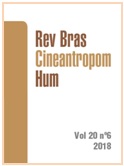Cardiorespiratory fitness in children and adolescents
DOI:
https://doi.org/10.1590/1980-0037.2018v20n6p535Abstract
Cardiorespiratory fitness is an important health status indicator. The purpose of this study was to verify the cardiorespiratory fitness according to age group and gender in children and adolescents from Sergipe, Brazil. It is a cross-sectional study with sample consisting of 195 adolescents of both genders with mean age of 11.75 ± 3.0 years. For the characterization of participants, a questionnaire with age and gender identification designed by researchers was used. Subsequently, participants were submitted to anthropometric evaluation in order to estimate the maturational stage by means of the peak height velocity (PHV). The 20-meter back-and-forth test was used to estimate cardiorespiratory fitness. Two-way ANOVA was applied with sample divided into two groups (“up to 13 years” and “above 13 years”). Polynomial contrast was used to identify the type of tendency for cardiorespiratory fitness, and simple contrast for multiple comparisons. All procedures were performed using SPSS version 22.0 software, considering 5% significance level. In the “over 13 years” group, there was a significant effect on the cardiorespiratory capacity behavior according to “gender” [F(1, 45) = 5.54, p = 0.02, r = 0.33] and “age” [F(4.45) = 3.37, p = 0.02, r = 0.48]. The simple contrast identified increased cardiorespiratory fitness behavior in relation to age groups of 15 and 16 year when compared to the age group of 14 years. It was concluded that gender and age positively influence cardiorespiratory fitness from the maturational reference age in the study group.References
Baxter-Jones AD, Eisenmann JC, Sherar LB. Controlling for maturation in pediatric exercise science. Pediatr Exerc Sci 2005;17(1):18-30.
Machado DRL, Bonfim MR, Costa LT. Pico de velocidade de crescimento como alternativa para classificação maturacional associada ao desempenho motor. Rev Bras Cineantropom Desempenho Hum 2009;11(1):14-21.
Shephard RJ, Bouchard C. Population evaluations of health related fitness from perceptions of physical activity and fitness. Can J Appl Physiol 1994;19(2):151-173.
Ortega FB, Ruiz JR, Castillo MJ, Sjöström M. Pediatric rewiew physical fitness in childhood and adolescence: a powerful marker of health. Int J Obes (Lond) 2008;32(1):1–11.
Ferrari GLM, Bracco MM, Matsudo VKR, Fisberg M. Cardiorespiratory fitness and nutritional status of schoolchildren: 30-years evolution. J Pediatr (Rio J) 2013;89(4):366-73.
Ferreira RV, Leadl JC, Brunherotti MAA. Desempenho e indicadores cardiorrespiratórios. Rev Bras Med Esporte 2017; 23(3):189–93.
Silva RJS, Petroski EL. Consumo máximo de oxigênio e estágio de maturação sexual de crianças e adolescentes. Motri 2008;4(1):13-9.
Machado FA, Guglielmo LGA, Denadai BS. Velocidade de corrida associada ao consumo máximo de oxigênio em meninos de 10 a 15 anos. Rev Bras Med Esporte 2002;8(1):1-6.
Armstrong N. Aerobic fitness of children and adolescents. J Pediatr (Rio J) 2006;82(6):406-8.
Tomkinson GR, Lang JJ, Tremblay MS. Temporal trends in the cardiorespiratory fitness of children and adolescents representing 19 high-income and upper middleincome countries between 1981 and 2014. Br J Sports Med in press.
International Society for the Advancement of Kinanthropometry - ISAK. International standards for anthropometric assessment. Sydney: ISAK; 2001.
Mirwald RL, Baxter-Jones ADG, Bailey DA, Beunen GP. An assessment of maturity from anthropometric measurements. Med Sci Sports Exerc 2002;34(4):689–94.
Leger LA, Lambert J. A maximal multistage 20-m shuttle run test to predict VO2 max applied. Eur J Appl Physiol Occup Physiol 1982;49(1):1-12.
Cohen J. Statistical power analysis for the behavioral sciences. 2.ed. New York, USA: Lawrence Erlbaum Associates; 1988.
Miranda VPN, Faria FR, Faria ER, Priore SE. Somatic maturation and body composition in female healthy adolescents with or without adjustment for body fat. Rev Paul Pediatr 2014;32(1):78–84.
Armstrong N, Welsman JR. Peak oxygen uptake in relation to growth and maturation in 11 to 17-year-old humans. Eur J Appl Physiol 2001;85(6):546–51.
Ruiz JR, Castro-Piñero J, España-romero V, Artero EG, Ortega FB, Cuenca MM, et al. Field-based fitness assessment in young people: the ALPHA health-related fitness test battery for children and adolescents. Br J Sports Med 2011;45(6):518–24.
Machado FA, Guilherme L, Guglielmo A, Denadai S. Velocidade de corrida associada ao consumo máximo de oxigênio em meninos de 10 a 15 anos. Rev Bras Med Esporte 2002;8(1):8–13.
Pereira S, Katzmarzyk PT, Gomes TN, Souza M, Chaves RN, Karina F, et al. A multilevel analysis of health-related physical fitness: the portuguese sibling study on growth, fitness, lifestyle and health. PLoS One 2017;12(2):1–15.
Pelegrini A, Minatto G, Claumann G, Silva D, Grigollo L, Schwinn F, et al. Cardiorespiratory fitness in adolescents. Rev Andal Med Deport 2017;10(3):152–7.
Souza VS, Batista MB, Cyrino ES, Blasquez G, Serassuelo Junior H, Romanzini M, et al. Associação entre aptidão cardiorrespiratória e participação regular de adolescentes em esportes. Rev Bras Ativ Fís Saúde 2013;18(4):511–9.
Soares NMM, Silva RJS, Melo EV, Oliveira ACC. Cardiorespiratory fitness in school. Rev Bras Cineantropom Desempenho Hum 2014;16(2):223-32.



